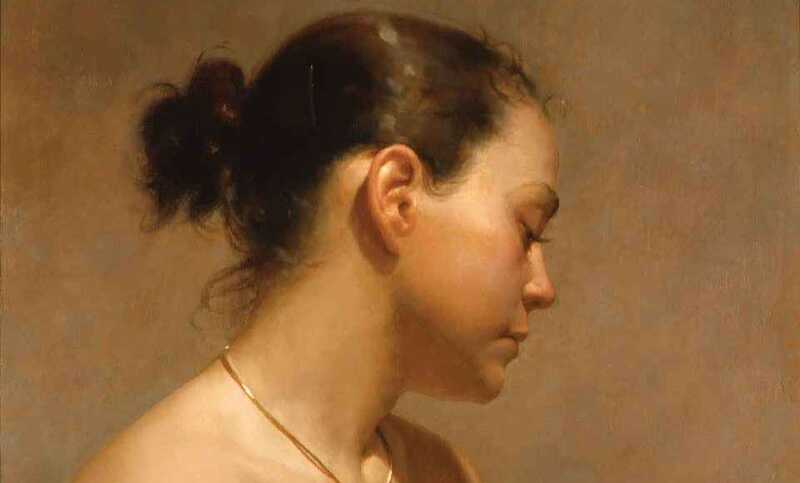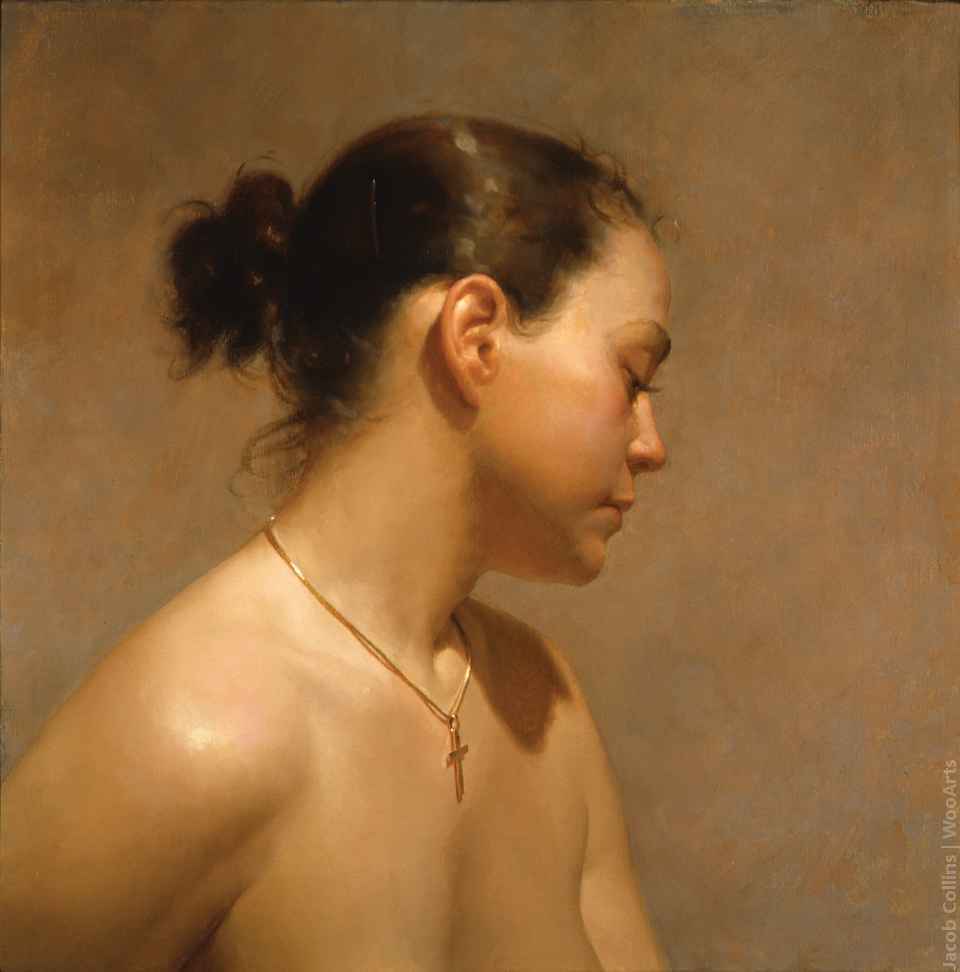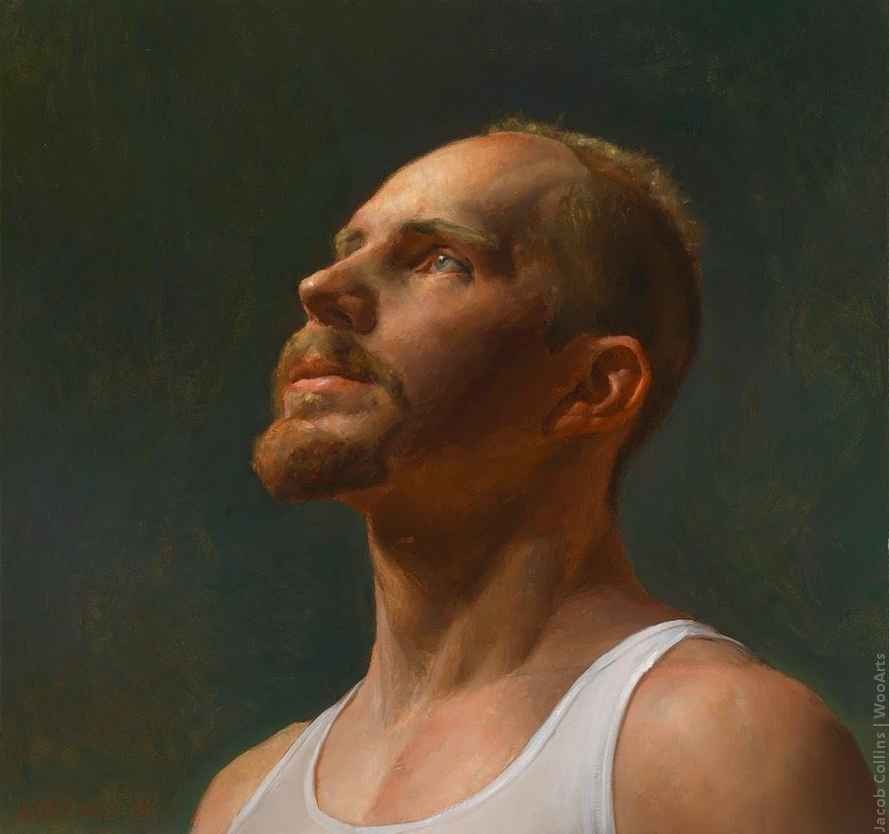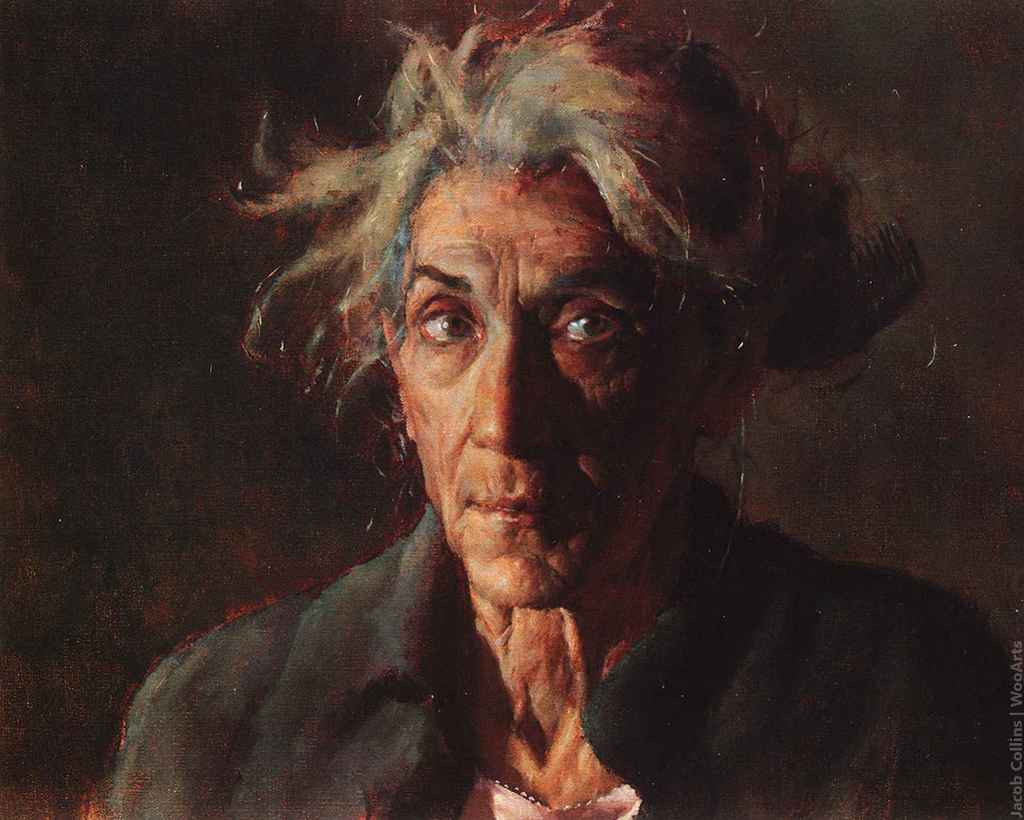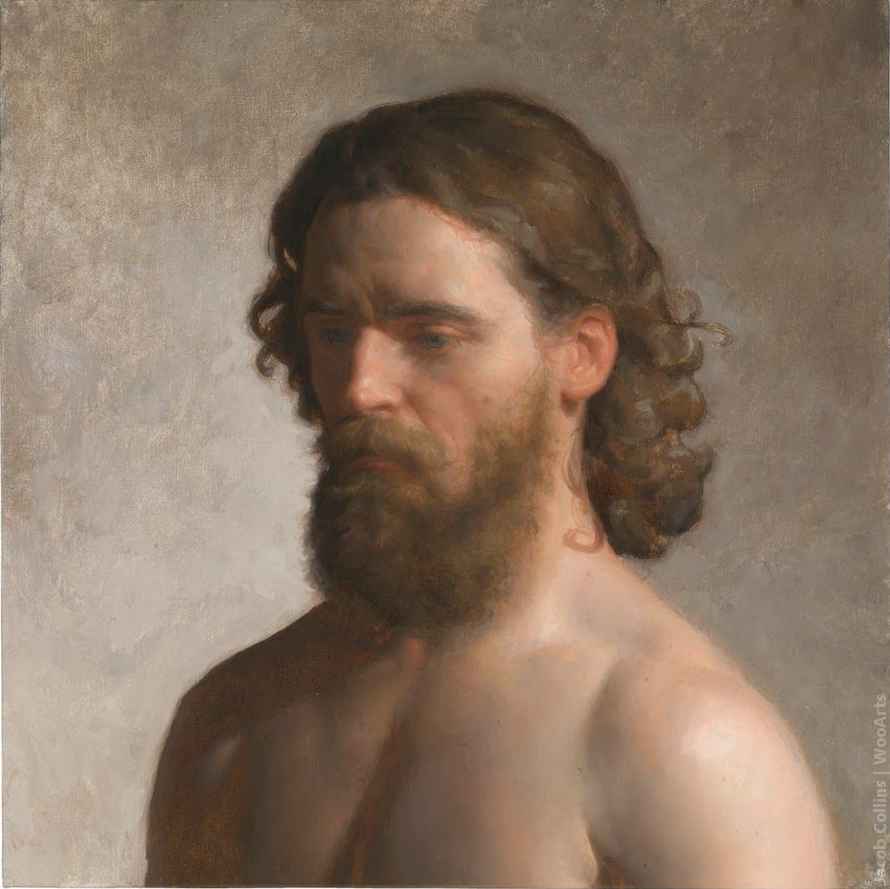While perhaps best known for his paintings of the figure, mainly of the female in repose, Jacob Collins is equally adept at still life and landscape. In fact, one quality all of his paintings share is a signature breath of light. This delicate illumination, accompanied by equally powerful darkness, caresses either skin, object or sky.
Collins’s style is frequently compared to that of the 19th-century painters, and although his paintings are certainly classical in approach, they have a decidedly contemporary look. Friend and former student Juliette Aristides says of his work, “Jacob’s paintings have a sublime tonal quality and his paint handling has the fluidity of an old master’s.”
An instructor at the Grand Central Academy of Art, a school he founded with several former students, Collins also runs the Water Street Atelier out of the ground floor of a Manhattan carriage house. It’s a home he shares with his wife, Ann Brashares—the bestselling author of The Sisterhood of the Traveling Pants, and their three children.
While hesitant to divulge painting techniques in the pages of a magazine (“A little learning is a dangerous thing…”), in this interview Collins opens up about some of his artistic influences and shares with readers a drawing demonstration.
Lisa Wurster is associate editor for The Artist’s Magazine
When did you decide to begin a life in art? I had a clear feeling from early on that I wanted to do this. Also, my grandmother was an artist and my parents were very encouraging; they saw how excited and driven I was and would buy me art books.
As a young man, I tried to draw accurately and expressively, though not in a particularly artistic way. To a certain extent, I was looking to the dynamic muscular figures in, say, Marvel comics. That natural segue from copying comics to looking at Michelangelo or Rubens happens for an awful lot of young artists, especially young boys.
It’s coming from a similar place—the desire to make these expressive, dynamic figures. So I found myself stepping from a childhood idiom to a slightly more grown-up one.
You mentioned Marvel comics as a childhood influence. Did you have a preferred comic book character? I really liked Spiderman—the way he could shoot his web out of his wrists, and he was agile and powerful. I guess that would be an early iteration of my passion for both the lyrical and the monumental.
With your wife an author and you an artist, it must be a very creative household. Have your three children expressed any interest in art? Yeah, Ann is upstairs and I’m downstairs (laughs). The children are still a little young: Sam is 12, Nate is 8 and Susannah is 5. They’re very creative and imaginative kids, but we’re certainly not putting any pressure on them.
For a long time, you copied the old masters in several museums. Do you recommend this to other artists? Yes, very much. When I was a teenager, I would go to the Met and copy from Rembrandt, Gustave Courbet and others, which I did for a number of years.
Most of the time when I copied, I did so in oil, watercolor or pencil, and although I wasn’t employed as an official copyist, I learned a great deal. I also copied from art books. It’s harder to copy a painting than a drawing out of a book, because with a painting, the texture and degrees of transparency are.
Collins started the Water Street Atelier on Water Street in Brooklyn in 1994 as a small and private atelier. The atelier is now located on the ground floor of Collins’s Manhattan home and serves a group of 15 students who work with the artist in a loosely structured program over the course of several years.
Generally, the students begin with drawing, progress to painting plaster casts of sculptures, and grisaille (a painting or drawing done in shades of gray), then finally, students begin painting the figure.
“The atelier is wonderful, but New York has so many artists who really care and love this approach to art, and it seemed that group was underserved,” Collins says. So he founded the Grand Central Academy of Art to offer highly focused training in drawing, painting and sculpture.
The academy runs on a three-year program, the first year of which is almost exclusively drawing studies. Currently, the school accepts 15 students a year into the program, and this year the program will be accepting its second group of first-year students. The school also offers intensive night classes and summer workshops.
Collins is currently working on his newest venture, the Hudson River School for Landscape, situated in the Catskills. Rather than a standard art class, this school may become a permanent fixture, much like an artist ‘s colony.
“Some colonies are located in beautiful places, with artists who aren’t interested in making beautiful paintings out of the landscape,” he says.
“This school would, I hope, bring together the reawakening love of the old American painters, the vigorous but unfocused scene of contemporary landscape painting, and the urgent need for renewed reverence for the land.” Classes begin this summer.
“I begin some drawings loosely, while others I start very carefully, drawing slow, crisp lines. When painting, I might start out with a transferred drawing or with a lot of messy paint and hope for the best,” says Collins.
“This demonstration for Marc (on page 35; graphite, 24×18), covers a few of the ideas that I think of when drawing the figure. I don’t want to give the impression that these stages represent a set of drawing rules. There are many ways to draw beautifully. It’s important to let the drawing be an investigation and sometimes, in order to investigate, you need to go off the path.”
Interview by Lisa Wurster
May I Introduce Jacob Collins?
by Courtney Jordan
Jacob Collins: Weekend With the Masters Instructor
Jacob Collins is a leading figure in the contemporary revival of classical painting. He earned a B.A. in history from Columbia College and attended the New York Studio School, the New York Academy of Art, and the Art Students League, all in Manhattan.
As a student, Collins also copied extensively in museums in America and Europe. His work has been widely exhibited in North America and Europe and is included in several American museums, and he has painted numerous private and public portrait commissions.
Collins is the founder of the Water Street Atelier, The Grand Central Academy of Art, and the Hudson River School for Landscape, all in New York. The methodology of the Grand Central Academy is built on the approaches taught in the ateliers of the 15th through 19th centuries and which we developed successfully at Water Street: cast drawing and grisaille painting, progressing through to figure drawing and ultimately to figure painting.
GCA’s core program, however, goes beyond this, with copying paintings at the Metropolitan Museum of Art, a thorough study of perspective, anatomy with écorché and dissection, portraiture, painting methods and materials, plein air oil sketch, color theory and composition, and art history for painters—all taught by professional artists.
The historical relationship between painting, sculpture and architecture is reflected in the core curriculum, which also introduces architectural drawing and figure sculpture. Each distinct stage in the student’s education was conceived and is controlled by a larger trajectory, the end of which is to give the student the skills and understanding necessary to create classically inspired paintings finely conceived and excellently executed.
He is represented by Adelson Galleries, in New York City; John Pence Gallery, in San Francisco; and Meredith Long & Co., in Houston, Texas, and he also regularly shows with Tree’s Place Gallery, in Orleans, Massachusetts. For more information on Collins, visit his website.
THE GRAND CENTRAL ACADEMY OF ART
In the fall of 2006, I founded The Grand Central Academy of Art with a group of fellow artists whom I hold in the highest regard. They are all alumni of my first school, The Water Street Atelier, and helped me make it what it has been for more than a decade: a place where serious students can acquire the foundation of a classical education.
I had spent several years since Water Street’s inception, however, thinking about how to make a more robust, more perfect classical art school, one that ultimately could not be accommodated in an atelier setting.
The Grand Central Academy — with its dedicated and talented teachers, larger physical space and more structured and contemplated curriculum — is my attempt to answer the surging desires of a generation of young artists who want the most rigorous and thorough education in the classical and traditional arts.
The Academy, first and foremost, offers a four-year full-time program, with around fifteen students in each year. The methodology is built on the approaches taught in the ateliers of the 15th through 19th centuries and which we developed successfully at Water Street: cast drawing and grisaille painting, progressing through to figure drawing and ultimately to figure painting.
GCA’s core program, however, goes beyond this, with copying paintings at the Metropolitan Museum of Art, a thorough study of perspective, anatomy with écorché and dissection, portraiture, painting methods and materials, plein air oil sketch, color theory and composition, and art history for painters — all taught by professional artists. The historical relationship between painting, sculpture and architecture is reflected in the core curriculum, which also introduces architectural drawing and figure sculpture.
Each distinct stage in the student’s education was conceived and is controlled by a larger trajectory, the end of which is to give the student the skills and understanding necessary to create classically inspired paintings finely conceived and excellently executed.
We have also recently created a sculpture core program at the GCA. The sculptors and painters start out drawing the casts and figure together. They will also study anatomy and art history together, but the sculptors will lean more towards three-dimensional work, eventually working full time in the sculpture studio.
The Grand Central Academy also offers a varied and comprehensive array of evening and weekend classes as well as workshops, all geared toward the serious student of classical art. The school sponsors lectures and festivals, and the tight-knit group of students frequently organizes book groups and talks, adding another dynamic to this already full and vibrant community.
The Academy is an intense community exposing students to the ideas and technical methods of a group of the leading classical artists in New York. Although these artists all have a great deal in common, their differences offer the students some variety of ideas. The GCA’s location in Midtown Manhattan has made it a natural center of the burgeoning renaissance in the classical arts that the United States and the rest of the world are enjoying today.
If you are interested in either the core program or the part-time courses at The Grand Central Academy of Art, please see its website:
THE HUDSON RIVER FELLOWSHIP
The Hudson River Fellowship will build a new movement of American art, modeling itself after the artistic, social and spiritual values of the Hudson River School painters. It will bring together the reawakening enthusiasm for the old American painters, the vigorous but unfocused scene of contemporary landscape painting and the urgent need for a renewed reverence for the land.
By bringing back the skills and spirit of the pre-impressionist landscape painters the program will give much needed direction to a new generation of painters. As they learn to carefully study and reflect on the trees and clouds and blades of grass and cliffs, their paintings will become beautiful. Ideally, these artists and their beautiful representations of nature will help to lead the culture back to a stronger connection to the landscape. The school seeks to make a contribution both to the art world and the conservation movement.
